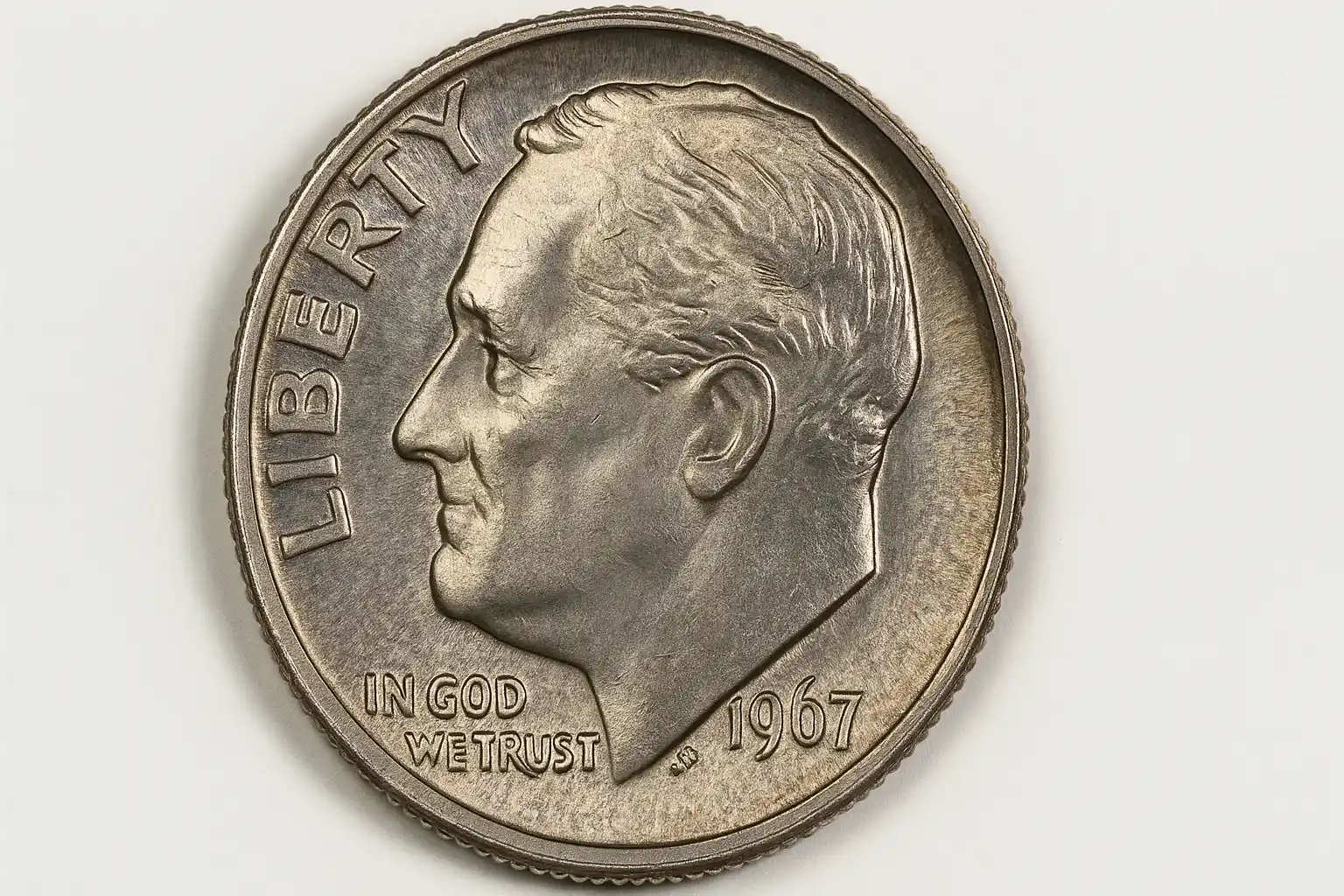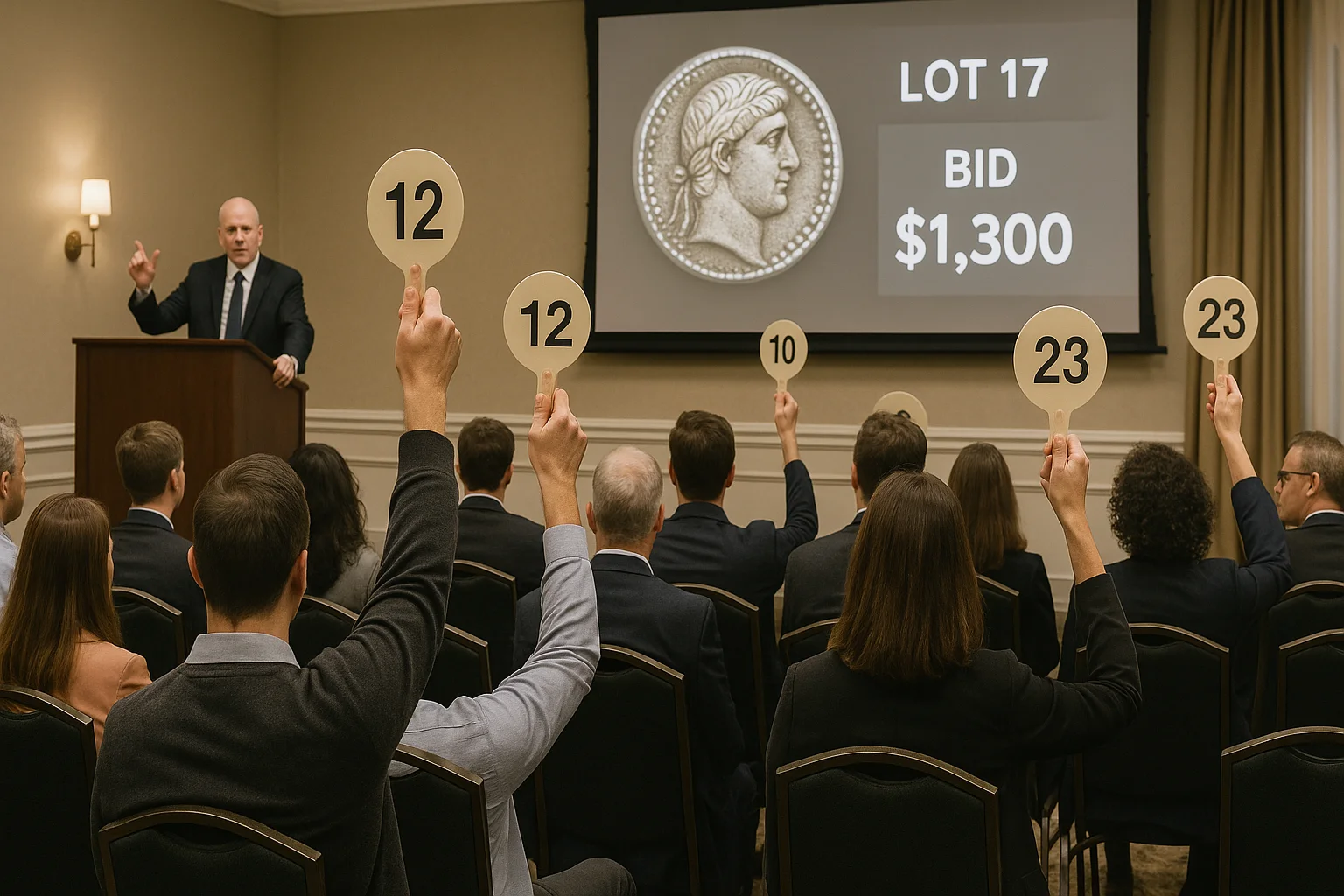How Much Is a 1967 Roosevelt Dime Worth Today?
The 1967 Roosevelt dime is a small but historically interesting coin in U.S. numismatics. It belongs to the Roosevelt series that began in 1946 and remains in use today.
Struck at the height of America’s transition away from silver coinage, the 1967 dime reflects a period when the Mint was dealing with widespread coin shortages. To discourage people from stockpiling coins, mint marks were temporarily removed between 1965 and 1967. This means that every dime dated 1967 looks the same regardless of which mint facility struck it.
On the obverse, the coin carries the familiar left-facing portrait of President Franklin D. Roosevelt, designed by John R. Sinnock. The inscriptions “LIBERTY” and “IN GOD WE TRUST” frame his profile, with the date 1967 appearing just below. The reverse features a central torch flanked by an olive branch on the left and an oak branch on the right, symbolizing liberty, peace, and strength. Above runs “UNITED STATES OF AMERICA,” while the denomination “ONE DIME” sits below, with “E PLURIBUS UNUM” across the center.
Unlike the silver dimes minted up to 1964, the 1967 dime has a clad composition of copper and nickel, with a pure copper core sandwiched between outer nickel layers. This gives the coin a total weight of 2.27 grams and a diameter of 17.9 millimeters. Its reeded edge is typical of the denomination. By design, the clad coinage was introduced to stretch the nation’s metal supply and prevent further hoarding of silver.
In terms of the 1967 dime value, the majority of 1967 dimes remain common and circulate at face value. Billions were struck, so survival rates are very high. Collectors, however, focus on high-grade uncirculated coins and those included in the Special Mint Sets produced from 1965 through 1967. Since proofs were suspended during these years, the SMS coins are the closest equivalent, with sharper details and better finishes than standard circulation strikes. The most desirable examples show strong contrast between frosted designs and mirror-like fields, known as Cameo or Deep Cameo finishes, and these command strong premiums at auction.

1967 Roosevelt Dime Value Guide
Type | Approximate Value | Notes |
Circulated (all grades) | $0.10 | Extremely common, no added value above face. |
Uncirculated MS60–MS63 | $0.50 – $1.50 | Readily available, slight premium for clean examples. |
Choice Uncirculated MS64–MS65 | $2 – $8 | Collectors prefer coins with strong luster and minimal marks. |
Gem Uncirculated MS66+ | $15 – $75 | Scarcer; registry collectors pay more for top population coins. |
Special Mint Set (SMS, typical) | $1 – $3 | Produced instead of proofs, better than circulation strikes. |
SMS Cameo | $10 – $30 | Strong frost on devices with mirrored fields; scarcer than standard SMS coins. |
SMS Deep Cameo | $40 – $150+ | Highest contrast coins, scarce in top grades, especially PR68–PR69. |
Errors (minor, e.g., small clips, light off-center) | $20 – $100 | Value depends on severity and eye appeal. |
Errors (major off-center, double strike, wrong planchet) | $200 – $1,000+ | Dramatic errors bring significant premiums. |
Mint Marks
In normal years, Roosevelt dimes carry small letters to indicate their place of production: “D” for Denver, “S” for San Francisco, and eventually “P” for Philadelphia starting in 1980. But in 1965 the United States Mint made a deliberate decision to remove mint marks from all coins. This policy lasted through 1967. The purpose was to reduce coin hoarding, which had become a problem after silver was removed from circulating coinage in 1965. Collectors at the time were setting aside rolls of coins by mint mark, and the Mint wanted to keep as many coins as possible in circulation during a nationwide shortage.
As a result, every dime struck in 1967 — whether it came from Philadelphia, Denver, or San Francisco — carries no mint mark. To the collector’s eye, they are indistinguishable from one another. This makes the 1967 dime unique in the Roosevelt series, because most other dates can be separated by mint origin.
Although there are no mint mark varieties for this year, collectors often pay closer attention to Special Mint Set (SMS) coins from San Francisco. These sets replaced proofs in 1965, 1966, and 1967, and although they also lack mint marks, their sharper strikes and improved finish set them apart from circulation coins. High-grade SMS dimes with Cameo or Deep Cameo contrast are considered the closest equivalent to a proof issue for 1967.
Errors
Off-Center Strikes
An off-center strike occurs when the planchet is not properly aligned in the coin press. The dies strike only part of the blank, leaving a crescent of unstruck metal on one side. On a 1967 dime, small off-centers of less than 10 percent are common and may bring only a modest premium. Collectors, however, are most interested in dramatic errors of 30 to 50 percent or more, particularly when the date remains fully visible. The presence of the date ensures authentication and makes the coin far more desirable. Well-centered off-centers of this type can reach values of several hundred dollars depending on grade and eye appeal.
Double Strikes
A double strike happens when a coin fails to eject from the press after the first strike and receives a second impression. The second strike can land directly on top of the first, producing a slightly doubled image, or it can land off to the side, creating two distinct overlapping designs. On a 1967 dime, a double strike may show Roosevelt’s profile shadowed or repeated, or the torch and branches on the reverse appearing doubled or partially rotated. Minor doubling adds some value, but dramatic double strikes are rare and command strong prices, often into the high hundreds.
Clipped Planchets
Clipped planchets occur when a blanking punch overlaps the edge of a metal sheet during production. The resulting planchet is missing a section, which carries through after striking. On a 1967 dime, a curved or straight clip at the rim gives the coin the appearance of a missing bite. Collectors appreciate these errors because they are instantly visible and cannot be confused with damage. Small clips may sell for a few dozen dollars, while large or multiple clips can increase the premium substantially. The most valuable examples are those that still show complete design details despite the missing portion.
Broadstrikes
A broadstrike is created when a coin is struck outside of the restraining collar that normally holds the metal in place. The coin expands outward, creating a wider and flatter piece with weak or missing rims. On a 1967 dime, broadstrikes are striking because the coin looks oversized compared to normal issues. These errors can range from slightly expanded rims to extreme spreads where the design appears stretched. Values depend on the degree of expansion and overall eye appeal, with strong, well-centered broadstrikes commanding well over $100 in attractive condition.
Die Cracks and Cuds
As dies wear or become damaged, they may develop fractures that transfer raised lines onto struck coins. These are called die cracks. If a piece of the die breaks away completely, the resulting void fills with metal, creating a raised blob attached to the rim or design, known as a cud. On 1967 dimes, small cracks are relatively common and inexpensive, but large rim cuds are much scarcer and can bring notable premiums. A dramatic cud that interrupts the design can easily sell for several times the value of an ordinary dime. Collectors often pursue these pieces because they represent the physical breakdown of the dies themselves.
Struck-Through Errors
Struck-through errors occur when foreign material becomes trapped between the die and the planchet during striking. The object may be grease, cloth, wire, or even a fragment of another coin. On a 1967 dime, struck-through errors may appear as blank depressions, missing design details, or unusual textures on the surface. These are particularly interesting to specialists because each example is unique, shaped by whatever debris was present at the time. Values typically start around $50 but can climb well above $100 if the strike-through is large or dramatic.
Wrong Planchet Strikes
One of the rarest and most valuable errors for this issue is a wrong planchet strike. This happens when a blank intended for another denomination or even a foreign coin is accidentally fed into the press. A 1967 dime struck on a cent planchet, for example, would be copper-colored and slightly larger in size, while one struck on a foreign blank might appear undersized or have an unusual metal composition. Because these errors are rare and easily recognized, they attract strong interest at auction. Depending on the planchet, values can range from several hundred dollars to well over $1,000.

Value Predictions for 5 Years
Circulated Coins
Ordinary 1967 dimes that have been used in commerce will almost certainly remain at face value. With billions struck, there is no shortage of supply. Five years from now, a circulated 1967 dime is still expected to be worth 10 cents.
Uncirculated Business Strikes
Common uncirculated examples in grades MS60–MS64 are widely available and trade for a dollar or two today. With no rarity and little collector pressure, values are expected to remain stable. By 2030, these coins will likely still be in the $1–$3 range, with no real appreciation.
High-Grade Uncirculated (MS66 and MS67)
Condition rarities, especially certified MS66 and above, are where modest growth can be expected. Registry set competition has kept premiums firm, and as population reports stabilize, small price gains are possible. Current MS66 coins at $40–$75 may edge up to $60–$100, and MS67 examples, now in the low hundreds, could see increases to $150–$250 depending on demand.
Special Mint Set (SMS) Coins
Standard SMS dimes trade in the $1–$3 range and are unlikely to change. The real movement will be in Cameo and Deep Cameo SMS coins, especially in PR68–PR69. Today, Cameos bring $20–$40, and Deep Cameos $75–$150. In the next five years, these could reasonably climb to $30–$60 for Cameos and $125–$200 for Deep Cameos, given steady collector interest in modern proofs and near-proofs.
Errors and Varieties
The strongest growth will continue to be in major errors — off-center strikes with full dates, dramatic double strikes, and wrong planchet pieces. These coins already sell for hundreds, and auction demand for unique, eye-catching errors is rising. Over the next five years, dramatic examples could appreciate by 20–40%, with $500 errors today moving toward the $600–$700 range. Common minor errors, such as small clips or light off-centers, will stay relatively stable at $20–$50.
Overall Outlook
The 1967 dime will not suddenly become rare. Its base-level value will remain face, and lower-grade uncirculated coins will stay inexpensive. The best investment path lies in top-grade certified MS66–MS67 examples, Cameo and Deep Cameo SMS coins, and major dramatic errors. These categories already attract serious collectors, and in five years they are likely to command stronger premiums as populations shrink and demand continues.
Anyway, you can always check the price with a Coin ID Scanner app!
